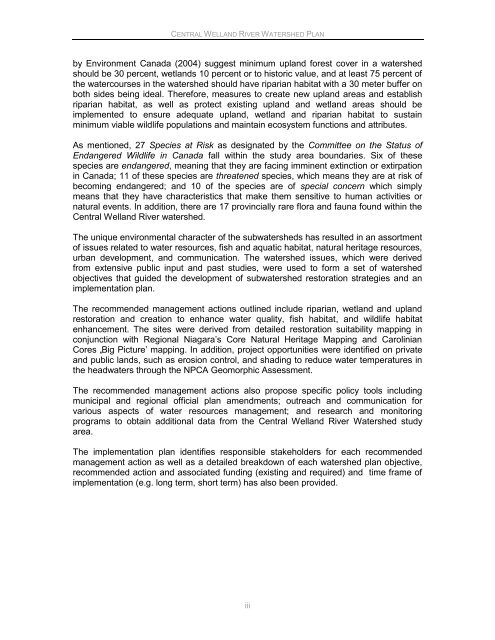Central Welland River Watershed Plan - Niagara Peninsula ...
Central Welland River Watershed Plan - Niagara Peninsula ...
Central Welland River Watershed Plan - Niagara Peninsula ...
- No tags were found...
Create successful ePaper yourself
Turn your PDF publications into a flip-book with our unique Google optimized e-Paper software.
CENTRAL WELLAND RIVER WATERSHED PLANby Environment Canada (2004) suggest minimum upland forest cover in a watershedshould be 30 percent, wetlands 10 percent or to historic value, and at least 75 percent ofthe watercourses in the watershed should have riparian habitat with a 30 meter buffer onboth sides being ideal. Therefore, measures to create new upland areas and establishriparian habitat, as well as protect existing upland and wetland areas should beimplemented to ensure adequate upland, wetland and riparian habitat to sustainminimum viable wildlife populations and maintain ecosystem functions and attributes.As mentioned, 27 Species at Risk as designated by the Committee on the Status ofEndangered Wildlife in Canada fall within the study area boundaries. Six of thesespecies are endangered, meaning that they are facing imminent extinction or extirpationin Canada; 11 of these species are threatened species, which means they are at risk ofbecoming endangered; and 10 of the species are of special concern which simplymeans that they have characteristics that make them sensitive to human activities ornatural events. In addition, there are 17 provincially rare flora and fauna found within the<strong>Central</strong> <strong>Welland</strong> <strong>River</strong> watershed.The unique environmental character of the subwatersheds has resulted in an assortmentof issues related to water resources, fish and aquatic habitat, natural heritage resources,urban development, and communication. The watershed issues, which were derivedfrom extensive public input and past studies, were used to form a set of watershedobjectives that guided the development of subwatershed restoration strategies and animplementation plan.The recommended management actions outlined include riparian, wetland and uplandrestoration and creation to enhance water quality, fish habitat, and wildlife habitatenhancement. The sites were derived from detailed restoration suitability mapping inconjunction with Regional <strong>Niagara</strong>‟s Core Natural Heritage Mapping and CarolinianCores „Big Picture‟ mapping. In addition, project opportunities were identified on privateand public lands, such as erosion control, and shading to reduce water temperatures inthe headwaters through the NPCA Geomorphic Assessment.The recommended management actions also propose specific policy tools includingmunicipal and regional official plan amendments; outreach and communication forvarious aspects of water resources management; and research and monitoringprograms to obtain additional data from the <strong>Central</strong> <strong>Welland</strong> <strong>River</strong> <strong>Watershed</strong> studyarea.The implementation plan identifies responsible stakeholders for each recommendedmanagement action as well as a detailed breakdown of each watershed plan objective,recommended action and associated funding (existing and required) and time frame ofimplementation (e.g. long term, short term) has also been provided.iii
















